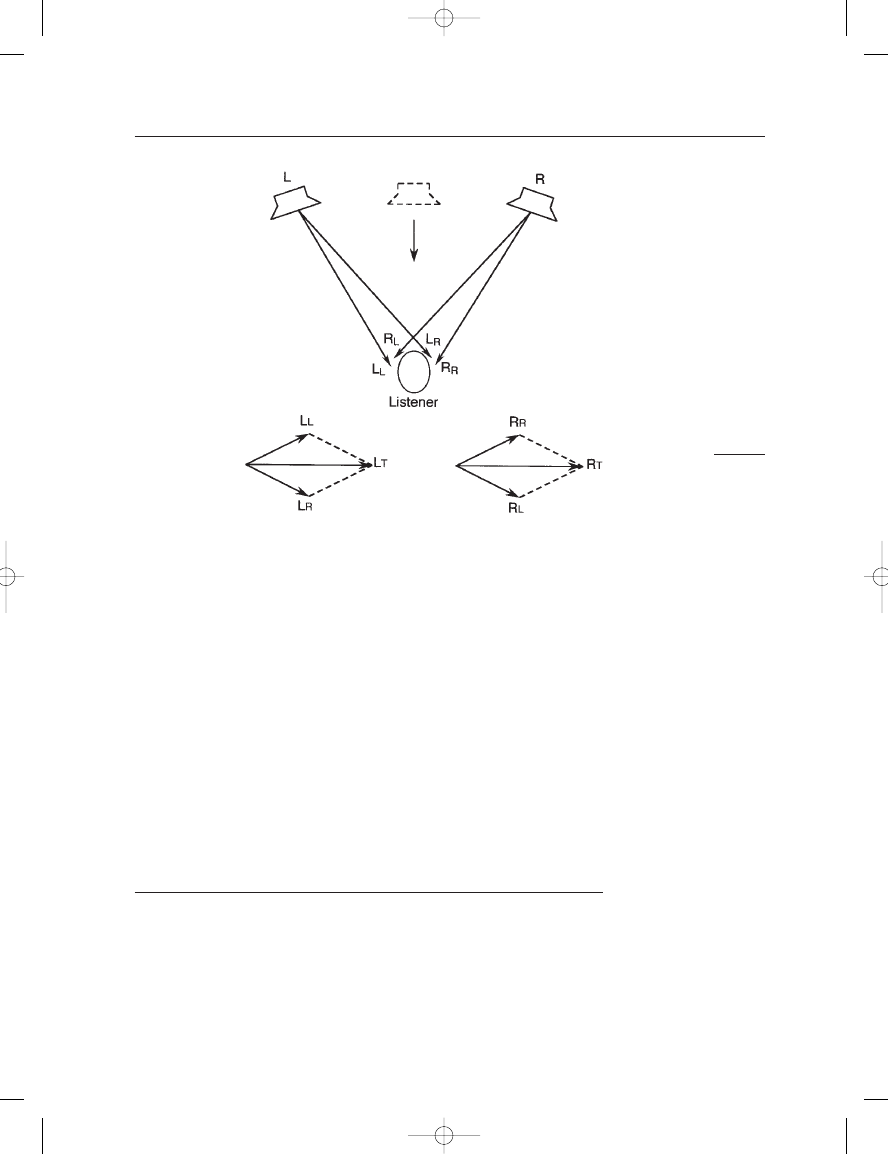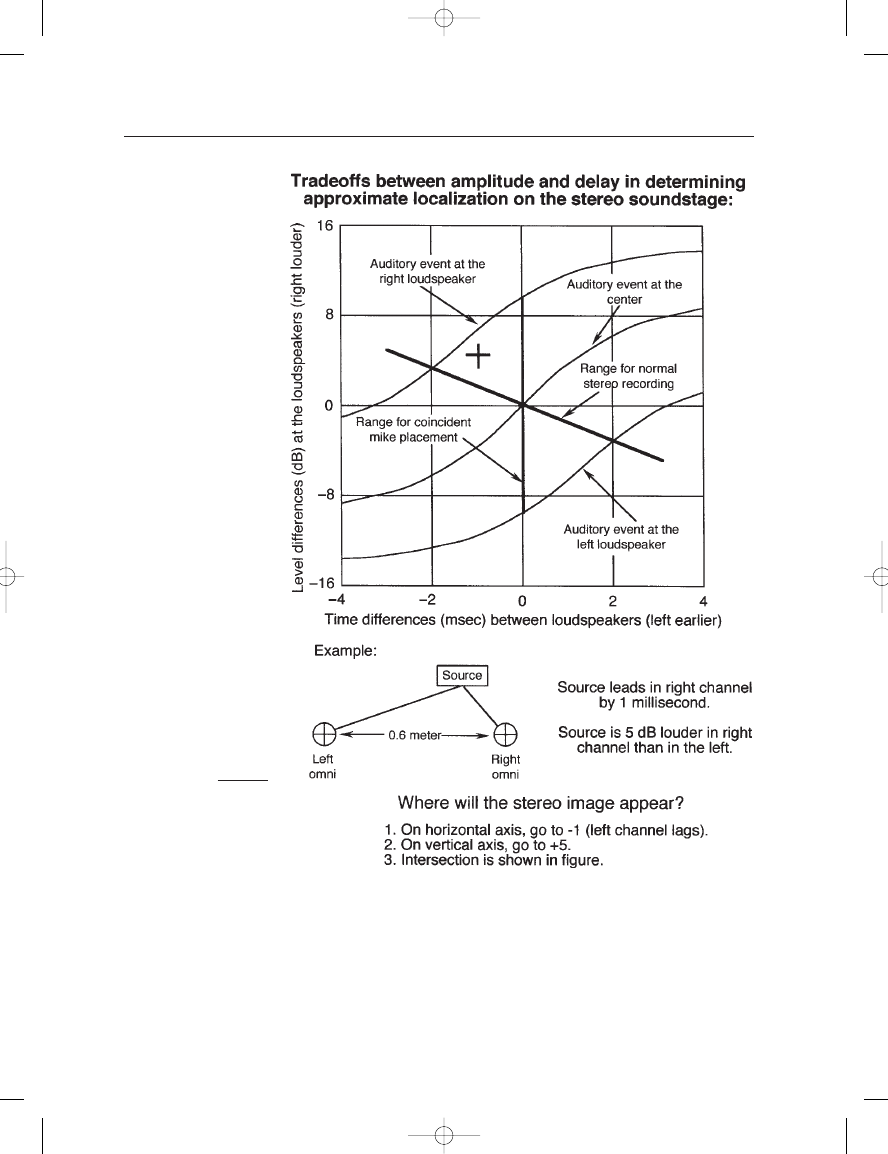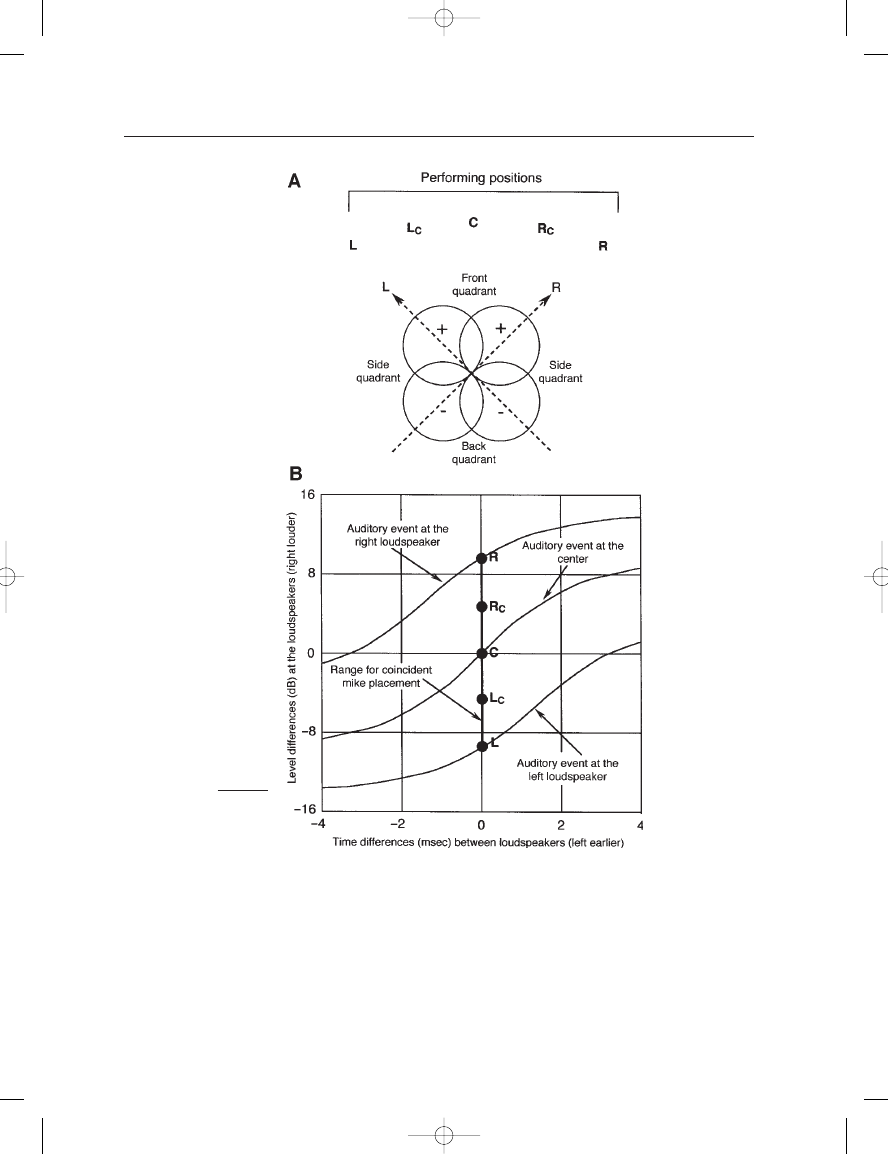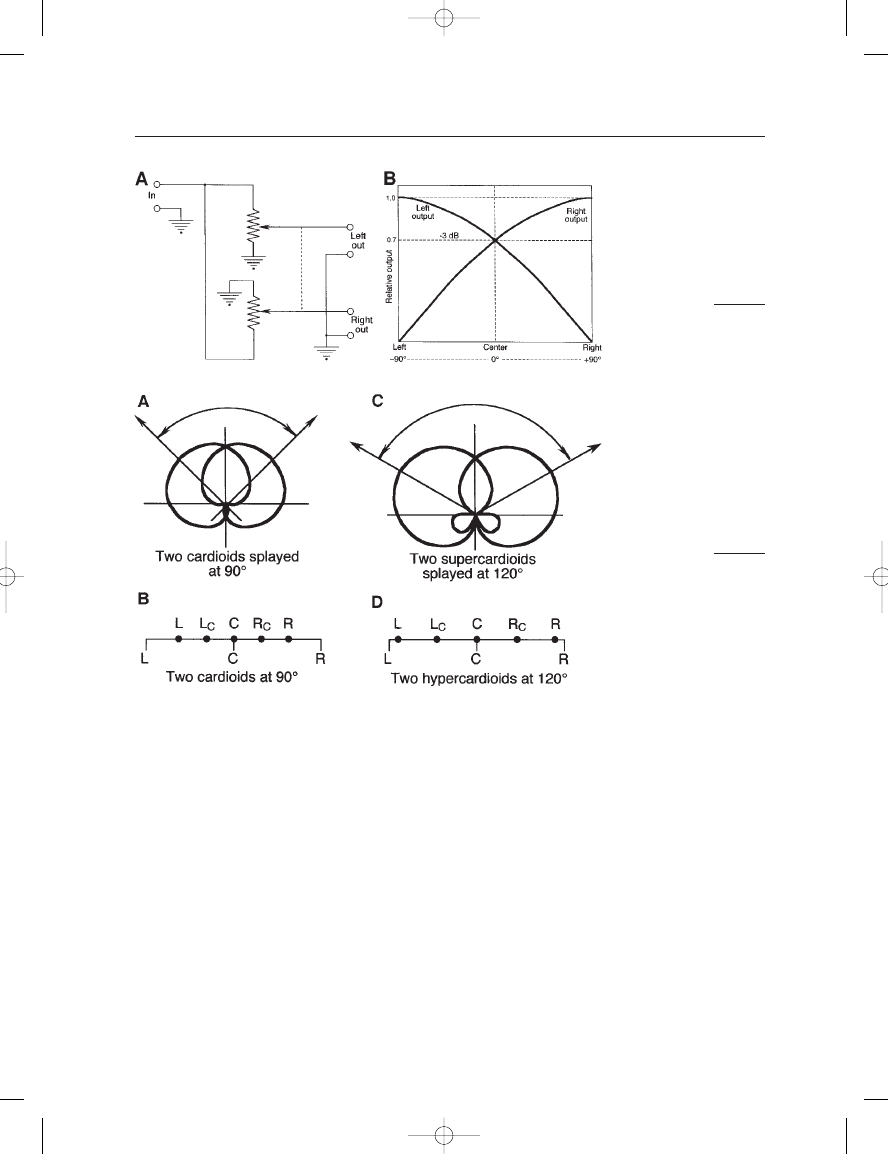ВУЗ: Казахская Национальная Академия Искусств им. Т. Жургенова
Категория: Книга
Дисциплина: Не указана
Добавлен: 03.02.2019
Просмотров: 17299
Скачиваний: 51

THE MICROPHONE BOOK
168
THE EFFECT OF DELAYED SIGNALS AT HIGH FREQUENCIES
In addition to the effect of low frequency phasors, small discrete signal
delays between the two microphones at high frequencies can also influ-
ence phantom source localization. In normal recording operations, both
amplitude and time delay cues are at work, and their combined effect on
phantom source localization can be roughly estimated from the data pre-
sented in Figure 11–3. This data was presented by Franssen (1963) and
gives reasonably accurate estimated stereo stage localization for wide-
band signals such as the spoken voice. An example showing use of the
graph is given in Figure 11–3.
In subsequent discussions in this chapter we will refer to approxi-
mate localization analyses as determined by Franssen’s method. These
will be shown as horizontal plots with specific indications of left, left-
center, center, right-center, and right images as determined from the data
in Figure 11–3.
COINCIDENT STEREO MICROPHONE ARRAYS
Coincident microphone arrays consist of a pair of directional micro-
phones located virtually one atop the other and both individually
adjustable in their lateral pickup angles. As such, they respond only
to amplitude cues in the program pickup, since their proximity precludes
any time related cues. Coincident arrays are often referred to as X-Y
arrays.
FIGURE 11–2
Two loudspeakers
creating equal net phasors
at both ears.
Earg_11.qxd 14/9/04 2:50 PM Page 168

11: Basic Stereophonic Recording Techniques
169
CROSSED FIGURE-8s: THE BLUMLEIN ARRAY
The most notable example of the coincident array is a pair of figure-8
microphones arrayed at a lateral angle of 90
, as shown in Figure 11–4A.
This array, first described by Blumlein (1931, reprinted 1958), is unique
in that the sine and cosine angular relationships between the two pickup
FIGURE 11–3
Franssen’s data for
determining wide-band
stereo localization with
both amplitude and
time cues.
Earg_11.qxd 14/9/04 2:50 PM Page 169

THE MICROPHONE BOOK
170
pattern lobes retain constant signal power over the pickup angle due to
the relationship:
(sin
)
2
(cos )
2
1
(11.1)
This identity ensures that any sound source located in the front
quadrant of the array will be picked up with uniform power, since
acoustical power is proportional to the square of its respective compo-
nents. Specifically, when a sound source is directly in the middle of the
array, the values of both sin 45
and cos 45 will be 0.707, representing
a
3 dB reduction in level at both left and right loudspeakers. These two
half-power quantities will add acoustically in the listening space, yield-
ing a power summation of unity. Localization of the Blumlein array is
shown as determined by the Franssen graph shown in Figure 11–4B.
Any discussion of the Blumlein array leads directly to a discussion
of the panpot (panoramic potentiometer), a dual fader arrangement that
has one signal input and two signal outputs. Circuit details are shown
in Figure 11–5A, and the two outputs are as shown at B. Panpots are
found in the microphone input sections of virtually all recording con-
soles and can be used to steer a given input signal to any position on the
two-channel stereo sound stage. The two fader sections give sine and
cosine values corresponding to the rotary fader setting, providing uni-
form acoustical power whatever the setting. In this regard the panpot is
analogous to the Blumlein crossed figure-8 microphone pair operating
in its front or back quadrant.
The crossed figure-8 array maps the frontal quadrant of its pickup
with virtual accuracy. Likewise, the back quadrant is equally well picked
up, but in opposite polarity to that of the front quadrant. The left and
right side quadrants are picked up with their two components in reverse
polarity (often described as out of phase or in antiphase), and this cre-
ates a spatial ambiguity. As long as the side quadrants and the back
quadrant are relegated to “back of the house” reverberation, there
should be no adverse problems due to the polarity reversal.
The crossed figure-8 array is also known by the term Stereosonic
(Clark et al., 1958) as it was modified and applied by the Electrical and
Musical Industries (EMI) during the early days of the stereo LP in
England. In their application of the Blumlein array for commercial record-
ing, EMI recording engineers always introduced a slight amount of
in-phase crosstalk above about 700 Hz between the stereo channels. The
technique, known informally as “shuffling,” was used to match phantom
image localization at high frequencies with that normally produced by low
frequency phasor reconstruction at the listener’s ears (Clark et al., 1958).
In summary, Blumlein array performance:
1. Produces excellent stereo stage lateral imaging, due to the self
“panning” aspect of the frontal sine and cosine pickup lobes. Image
analysis by means of Franssen’s data indicates that the primary
sound sources will fill the entire stereo stage from left to right.
Earg_11.qxd 14/9/04 2:50 PM Page 170

11: Basic Stereophonic Recording Techniques
171
FIGURE 11–4
Crossed figure-8s (A);
localization via
Franssen (B).
2. Conveys an excellent sense of acoustical space, due to the added
pickup of reflected and reverberant signals in the recording space.
3. Often presents difficulties in microphone placement; specifically, a
wide array of performers may require that the microphone pair to
be placed too far from the performers for the desired degree of
presence.
Earg_11.qxd 14/9/04 2:50 PM Page 171

THE MICROPHONE BOOK
172
CROSSED CARDIOID ARRAYS
Figure 11–6A shows a crossed pair of cardioids that can be splayed over
an angle of 90
to 135. When the splay angle is about 90 the sound
stage appears center-heavy (i.e. mono-dominant), and sources located at
far-left and right will appear panned well into the array. This is not a use-
ful configuration, and most engineers will choose to widen the micro-
phone splay angle up to 135
. This has the effect of correcting mid-stage
balance with the sources at far left and right. But even then, the overall
stereo stage may appear a bit too narrow.
A better approach is shown in Figure 11–6C, where a pair of splayed
supercardioid microphones are used at an angle of 120
. Here, the rela-
tively narrow front lobe will spread left, center, and right stage events
naturally, while the smaller back lobes will pick up more room reflec-
tions and reverberation. In general, the crossed supercardioids, or hyper-
cardioids, make a good alternative to crossed figure-8 patterns in live
recording spaces, since the rear lobes will pick up less room sound and
FIGURE 11–5
Details of the panpot:
circuit (A): signal
outputs (B).
FIGURE 11–6
Variable crossed cardioids
(A); localization via
Franssen’s data for 90
cardioids (B); variable
crossed supercardioids (C);
localization via
Franssen’s data for 120
hypercardioids (D).
Earg_11.qxd 14/9/04 2:50 PM Page 172